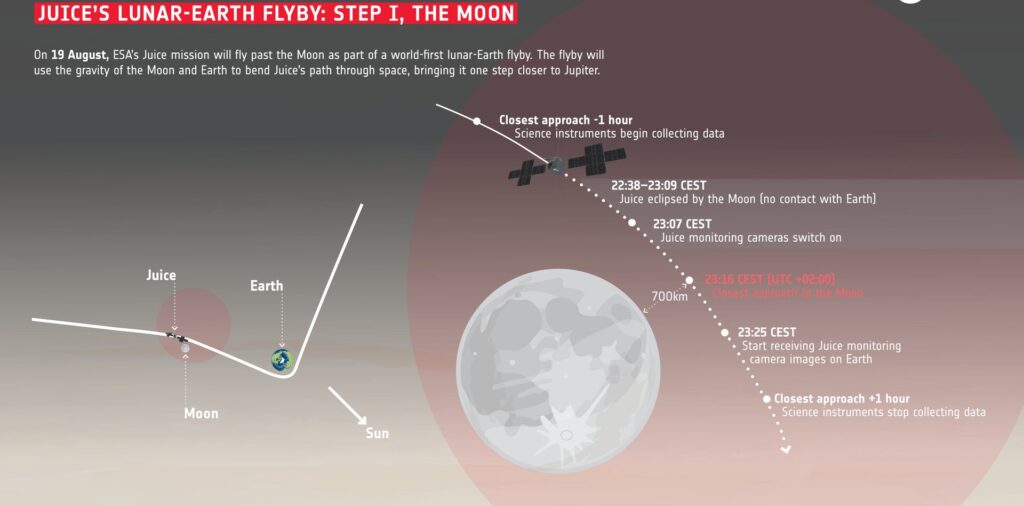On August 19–20, the European Space Agency’s (ESA) Jupiter Icy Moons Explorer (Juice) will perform a crucial maneuver known as the Lunar-Earth Flyby. This double gravity assist from the Moon and Earth will help guide Juice on a more efficient path to Jupiter, making use of a shortcut via Venus.
What is Happening?
This event marks two significant firsts in space exploration: the first lunar-Earth flyby and the first double gravity assist maneuver. These maneuvers will adjust Juice’s speed and trajectory, setting it on the correct path through space. However, any mistake could jeopardize the mission.
Launched in April 2023, this lunar-Earth flyby is the inaugural step in Juice’s journey through the Solar System towards Jupiter. Earth’s gravity will bend Juice’s path, effectively braking it and redirecting it towards Venus for an August 2025 flyby. Following this, Juice will gain additional energy boosts from Venus and two subsequent flybys of Earth, propelling it towards Jupiter.

Why is This Necessary?
Jupiter is approximately 800 million km from Earth. Directly sending Juice to Jupiter would require an impractical 60,000 kg of onboard propellant. Additionally, Juice would need more propellant to slow down and enter Jupiter’s orbit upon arrival.
Instead, Juice is using gravitational assists from other planets to adjust its course efficiently. This intricate route, developed over 20 years by Juice’s mission analysis team, ensures the spacecraft arrives at Jupiter with the correct speed and direction.
Counterintuitively, using the lunar-Earth flyby to slow down Juice is more efficient than speeding it up. If used to accelerate towards Mars, the next planetary flyby would be much further away. This braking maneuver acts as a shortcut through the inner Solar System.

How is it Being Executed?
Mission operators have precisely adjusted Juice’s trajectory to ensure it arrives at the Moon and Earth at the exact times needed, traveling at the right speed and in the correct direction. Despite the confidence of success, this maneuver is risky and unprecedented.
Ignacio Tanco, Juice’s Spacecraft Operations Manager, compares it to “passing through a very narrow corridor, very quickly, with minimal margin for error.”
Juice will approach both the Moon and Earth closely, requiring real-time precision in navigation. From August 17–22, Juice will maintain continuous contact with ground stations globally. Operators will monitor and adjust Juice’s path as necessary, ensuring it stays on course.

Bonus Science
In addition to the navigation challenge, ESA will activate Juice’s ten science instruments during the flyby. This provides a unique opportunity for instrument teams to collect data from the lunar and Earth surfaces, a first for some instruments during Juice’s eight-year journey.
This flyby is particularly crucial for the Radar for Icy Moon Exploration (RIME) instrument, currently affected by electronic noise within the spacecraft. During the Moon flyby on August 19, RIME will have eight minutes of solo observation to assess the noise impact. The RIME team will use this data to develop an algorithm to correct the noise issue.

Conclusion
Juice’s lunar-Earth flyby is a critical milestone in its journey to Jupiter. This complex maneuver not only sets the spacecraft on the right path but also provides valuable scientific opportunities. As Juice navigates this challenging phase, it brings us closer to uncovering the mysteries of Jupiter and its icy moons.








